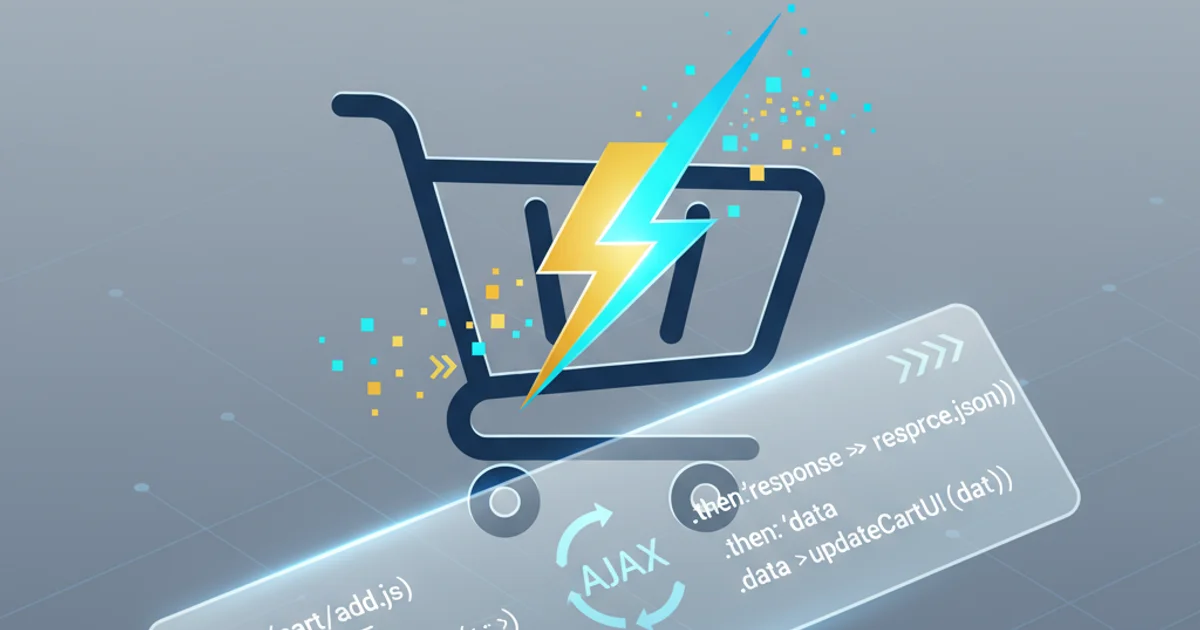Add to Cart using AJAX in Shopify
Categories:
Seamless Shopify Add to Cart with AJAX: A Comprehensive Guide

Learn how to implement an AJAX-powered 'Add to Cart' functionality in your Shopify store, enhancing user experience with instant feedback and no page reloads.
Integrating an AJAX 'Add to Cart' feature into your Shopify store significantly improves the user experience. Instead of a full page reload every time a customer adds an item to their cart, AJAX allows the action to happen in the background, providing instant feedback and a smoother shopping journey. This guide will walk you through the process, from understanding the Shopify AJAX API to implementing the necessary JavaScript and Liquid code.
Understanding Shopify's AJAX API for Cart Management
Shopify provides a robust AJAX API that allows developers to interact with the cart without full page reloads. The primary endpoints for adding items to the cart are /cart/add.js and /cart/update.js. When you send a POST request to /cart/add.js with the product variant ID and quantity, Shopify processes the request and returns the updated cart object as a JSON response. This enables you to dynamically update your cart icon, mini-cart, or provide other visual feedback to the user.
sequenceDiagram
actor User
participant Browser
participant ShopifyServer
User->>Browser: Clicks 'Add to Cart'
Browser->>Browser: Captures variant ID & quantity
Browser->>ShopifyServer: POST /cart/add.js (AJAX request)
ShopifyServer-->>Browser: Returns updated cart JSON
Browser->>Browser: Updates cart UI (e.g., item count, mini-cart)
Browser-->>User: Displays success message/updated cartSequence diagram of an AJAX 'Add to Cart' process
Prerequisites and Setup
Before diving into the code, ensure you have access to your Shopify theme's Liquid files. You'll typically be modifying files like product-template.liquid (or similar product section files) and potentially theme.liquid or a dedicated JavaScript file for your theme. Basic knowledge of HTML, CSS, JavaScript, and jQuery (if using) is recommended.
Implementing the AJAX 'Add to Cart' Logic
The core of the AJAX functionality involves preventing the default form submission and instead sending an asynchronous request. We'll use jQuery for simplicity, as it's often included in Shopify themes. The process involves selecting the product form, serializing its data, and sending it to the /cart/add.js endpoint.
<form action="/cart/add" method="post" id="product-form-{{ product.id }}">
<select name="id" id="product-select-{{ product.id }}">
{% for variant in product.variants %}
<option value="{{ variant.id }}">{{ variant.title }} - {{ variant.price | money }}</option>
{% endfor %}
</select>
<input type="number" name="quantity" value="1" min="1">
<button type="submit" name="add" id="add-to-cart-button-{{ product.id }}">Add to Cart</button>
</form>
Example product form in Liquid
$(document).ready(function() {
$('#product-form-{{ product.id }}').on('submit', function(e) {
e.preventDefault(); // Prevent default form submission
var $form = $(this);
var formData = $form.serialize(); // Serialize form data
$.ajax({
type: 'POST',
url: '/cart/add.js',
data: formData,
dataType: 'json',
success: function(item) {
// Item successfully added to cart
console.log('Item added:', item);
// Update cart count, mini-cart, or show success message
updateCartUI();
},
error: function(xhr, status, error) {
// Handle errors (e.g., out of stock)
console.error('Error adding to cart:', error);
var errorMessage = JSON.parse(xhr.responseText).description;
alert('Error: ' + errorMessage);
}
});
});
function updateCartUI() {
// Example: Fetch updated cart data and update UI elements
$.getJSON('/cart.js', function(cart) {
$('.cart-count').text(cart.item_count); // Update cart item count
// Further logic to update mini-cart contents
console.log('Cart updated:', cart);
});
}
});
jQuery AJAX 'Add to Cart' script
updateCartUI() function is a placeholder. You'll need to implement specific logic to update your theme's cart count, mini-cart, or other relevant UI elements based on your theme's structure. A common approach is to fetch the entire cart object using /cart.js after a successful add.Handling Multiple Products and Dynamic Forms
If your theme has multiple 'Add to Cart' forms (e.g., on collection pages or quick view modals), you'll need to ensure your JavaScript targets the correct form. Using classes instead of IDs for event listeners can make your code more reusable. Also, consider how to handle dynamic content loaded via AJAX, as event listeners might need to be delegated or re-initialized.
$(document).on('submit', '.product-form', function(e) {
e.preventDefault();
var $form = $(this);
var formData = $form.serialize();
// ... AJAX request as above ...
});
Using delegated event handling for dynamically loaded forms
By following these steps, you can successfully implement an AJAX 'Add to Cart' feature in your Shopify store, providing a much smoother and more engaging shopping experience for your customers. Remember to test thoroughly across different browsers and devices.